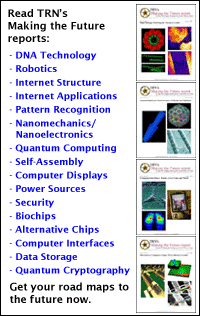
Ice
transforms chipmaking
By
Eric Smalley,
Technology Research NewsHarvard University scientists have taken ice sculpture to a new level -- that of molecules.
The researchers showed that molecular-scale layers of ice could be made easily and cheaply and then etched with electron or ion beams.
The method promises to make it easier for researchers to make nanoscale machines, and could someday make for an inexpensive, environmentally-friendly way to make computer chips.
The researchers showed that simply spraying water vapor onto a cryogenically cooled surface produces a nanoscale layer of ice. They initially used the technique to immobilize carbon nanotubes in order to cut them to specific lengths using an ion beam, then later realized that water ice condensed on cold silicon could be used as a lift-off fabrication resist in place of the more usual polymer resists, said Gavin King, a researcher at Harvard University.
Lift-off resists are thin coatings applied to silicon wafers in the chip fabrication process. These thin films are easily etched with light, electron or ion beams to expose the underlying silicon wafer in patterns that outline computer circuits. The exposed silicon is then chemically altered to change its electrical properties in order to make the microscopic wires in computer chips. The remaining resist, which protected the rest of the silicon wafer, is then chemically removed.
Using ice instead of plastics means the resist can be removed by rinsing with alcohol, heating, or drying rather than applying harsh chemical solvents, said King.
The ice process also promises to be less expensive than existing processes. Today's resists are typically formed by applying a small amount of liquid polymer onto a wafer, spinning the wafer at high speed to spread the polymer to an even thickness, and then baking the wafer to harden the plastic. The ice resist his formed by spraying water vapor onto chilled silicon wafers, said King. "Even without optimization, this simple water ice resist was used to produce sub 20-nanometer metal lines," he said.
To demonstrate the process, the researchers deposited a vapor of chromium onto a silicon wafer covered with a layer of ice that they etched nanoscale lines into. The chromium adhered to the silicon where it was exposed. They were able to make chromium lines as narrow as seventeen nanometers this way.
The researchers also found that the combination of electron beams and water chemically altered the silicon surface to produce what the researchers speculate is silicon oxide. "Because the thickness of the transformed material is strictly limited by the amount of ice that is deposited, we are able to control the depth of this chemical transformation down to a sub-nanometer scale," said King.
A 75-nanometer layer of ice produced a 3-nanometer-thick line of chemically-altered silicon and a 5 nanometer layer of ice yielded a 0.5 nanometer thick line of the material.
The line width of the material depends on the strength of electron beam, according to King. The stronger the beam, the narrower the line. The researchers were able to make lines as narrow as 5 nanometers.
Using gasses other than water vapor to make the ice layer would allow researchers to control whether a reaction occurs on the silicon surface and the composition of the resulting material, according to King. This could be used to make components of transistors and other nanoscale electronic devices, he said.
A major question is whether light beams rather than electron or ion beams can be used to etch the ice, said King. If so, nanopatterned ice could be used to simplify commercial chipmaking and make the process more environmentally sound, he said.
Even if electron or ion beams are required, the process could be used practically, said King. "Patterning ices of any condensed gas is a straightforward and practical process that may be particularly valuable for one-of-a-kind or low-volume fabrications where the slow production rates that are achievable with electron or ion beams can be tolerated," he said.
The technique could be used in within two years to pattern nanoscale electro-mechanical devices within the research community.
King's research colleagues were Gregor Schürmann, Daniel Branton and Jene A. Golovchenko. They published the research in the May 29, 2005 issue of Nano Letters. The research was funded by the National Science Foundation (NSF), the Department of Energy (DOE), the National Institutes of Health (NIH) and Agilent Technologies.
Timeline: < 2 years
Funding: Government; Corporate
TRN Categories: Materials Science and Engineering; Integrated Circuits; Nanotechnology
Story Type: News
Related Elements: Technical paper, "Nanometer Patterning with Ice," Nano Letters, May 29, 2005
Advertisements:
August 10/17, 2005
Page One
Stories:
System carries PC soul
Letter: a short history of TRN
Plug-in protects passwords
Ice transforms chipmaking
Pixels speed quantum crypto
Briefs:
Textures ID paper and plastic
DNA process stamps patterns
Templates yield nano branches
Chemistry moves micro machines
News:
Research News Roundup
Research Watch blog
Features:
View from the High Ground Q&A
How It Works
RSS Feeds:
News
Ad links:
Buy an ad link
| Advertisements:
|
 |
Ad links: Clear History
Buy an ad link
|
TRN
Newswire and Headline Feeds for Web sites
|
© Copyright Technology Research News, LLC 2000-2006. All rights reserved.